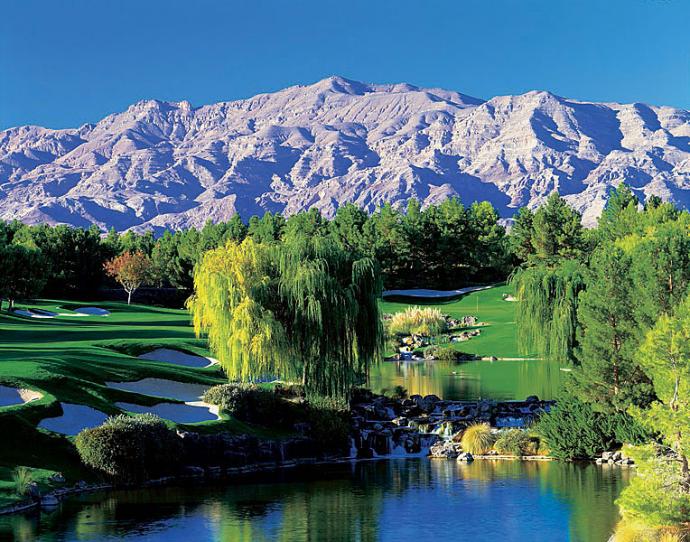Where to hold ‘em, where to fold ‘em? America offers a plethora of choices for players who favor games of chance, many of them operated by Native American Tribal Nations. At each, you can putt on smooth fast greens by day and up the ante on even smoother, faster green felt tables at night.
Arizona: We-Ko-Pa Golf Club’s Saguaro and Cholla courses are on every desert connoisseur’s list of the top public-access tracks in the Grand Canyon State. Owned by theFort McDowell Yavapai Nation,this housing-free, walker-friendly complex, ringed by stark mountains, blends seamlessly into the High Sonoran desert east of Scottsdale.
We-Ko-Pa pairs nicely with the Radisson Fort McDowell Resort & Casino, a AAA Four Diamond resort with slots, blackjack, live keno and No Limit Texas Hold ‘em Tournaments.
California: On a desert plateau ringed by sage-covered hills 30 miles east of San Diego, the Barona Band of Mission Indians built a ranch-themed resort and casino in 2001 that sets the pace for golf and gaming in gilded So Cal. Over 170 mature native oaks were transplanted from other parts of the reservation to frame Barona Creek Golf Club, a firm, fast, links-style course staked out by sharp-edged bunkers, rocky outcrops and a series of ponds fed by spidery streams. Barona Resort & Casino features 2,000 slots, over 80 table games, six restaurants and a deluxe 400-room hotel with a full-service spa.
Connecticut: Conceived and financed by the Mashantucket Pequot Tribal Nation, the $70 million Lake of Isles complex features two Rees Jones-designed courses (the South is private, the North is open to resort play). Blasted from a rockbound site, the layouts trace sloping, wooded ridges within a natural bowl that drops down to a lovely lake. The club is anchored by a Craftsman-style clubhouse built from stone and wood harvested on site.
Golf packages are available at a trio of Foxwoods Resort Casino hotels: MGM Grand, Grand Pequot Tower and Great Cedar Hotel, each with its own casinos, restaurants and clubs.
Idaho: Not far from where Lewis and Clark stopped for supplies on their journey west is the sprawling homeland of the Coeur d’Alene Indian Tribe and its eponymous casino resort. The resort’s buffets are adequate and the noisy casino, with its video blackjack dealers, are about what you’d expect in these parts. The reason to blaze a trail to Idaho is Circling Raven Golf Club, a majestic high-prairie track that weaves around tall Ponderosa pines, native Palouse grasses and cattailed wetlands. Elk, deer, moose and fox sightings are common. And yes, ravens circle overhead.
Indiana: Following an extensive $500 million makeover, French Lick Resort is now the golf-and-gaming midway of the Midwest. In addition to a pair of restored landmark hotels and a sparkling new casino, the resort, renowned for its mineral springs, offers two very different golf experiences.
The Pete Dye Course, opened in 2009, is an 8,102-yard behemoth carved into hilltops high above Hoosier National Forest. No one plays from the tips. No one can. On the other hand, the historic Donald Ross Course (1917), fully restored to Ross’s original plans, is a pleasure to play, as is the Valley Links, a sporty nine-holer that welcomes walkers. .
Minnesota: The northeast corner of Minnesota is about as far north as you can get in the U.S. without running into polar bears. But once the ice melts, Fortune Bay Resort Casino, built by the Bois Forte Band of Chippewa, offers genuine hospitality, two gaming floors and the chance to see the throbbing colored lights of the aurora borealis during the summer months. The resort’s pride and joy is the Wilderness at Fortune Bay, a grand-scale course marked by granite rock outcrops, towering pines and dramatic views of Vermilion Lake, named one of the nation’s most scenic lakes by “National Geographic.” The walleye fishing is excellent.
Mississippi: East of the Natchez Trace Parkway on tribal land belonging to the Mississippi Band of Choctaw Indians, Tom Fazio and Jerry Pate joined forces to develop the state’s greatest asset since Elvis came of age in nearby Tupelo.
Dancing Rabbit Golf Club’s well-groomed Azaleas and Oaks courses roll through red clay hills crossed by streams and framed by oaks and pines. Spring, when the dogwoods and azaleas burst into bloom, is the best time to go. Dancing Rabbit’s lodging partner is Pearl River Resort, a bustling getaway that bills itself as “Vegas with Sweet Tea.”
Nevada: There are lots of options in Las Vegas, but for serious players (golfers, that is), the nation’s best casino-affiliated course is Shadow Creek, a stunning stage set built in 1989 by Tom Fazio for Steve Wynn for a reported $46 million. A holy grail for high rollers, the oasis-like club offers lush vegetation, specimen trees, gurgling creeks, rolling fairways, perfect greens and exotic birdlife. No Vegas illusionist can top it. Guests of MGM Resorts International properties, including Bellagio, Aria, Mandalay Bay and The Mirage, can access Shadow Creek. Transportation to the club is via private limo.
New York: Against all odds, the Oneida Indian Nation’s Turning Stone Resort Casino in upstate New York has established itself as the Northeast’s top golf resort. In addition to Vegas-style gaming, live entertainment and a wide range of dining choices (from Manhattan deli to gourmet Asian), the resort’s three superlative courses are the main drawing card. Led by Atunyote, a refined parkland spread by Tom Fazio that formerly hosted a PGA Tour event, Turning Stone is the Empire State’s best-kept golf secret. Accommodations range from the Lodge, an understated 95-suite hostelry that evokes a traditional Adirondack lodge; to the 19-story Tower, a beehive of action.













